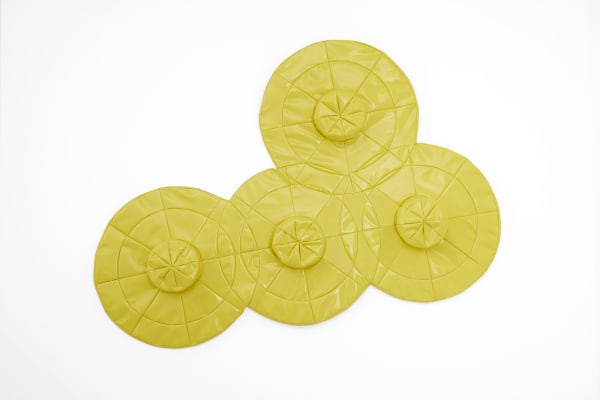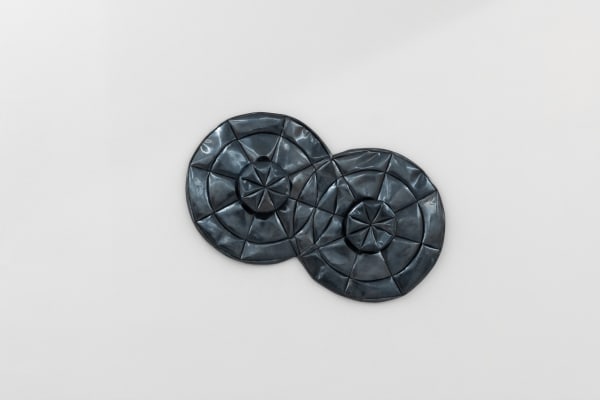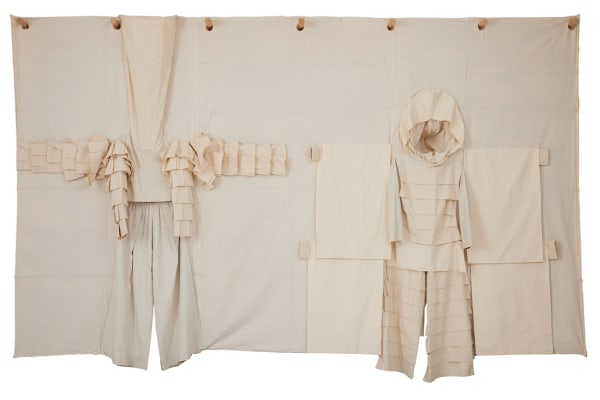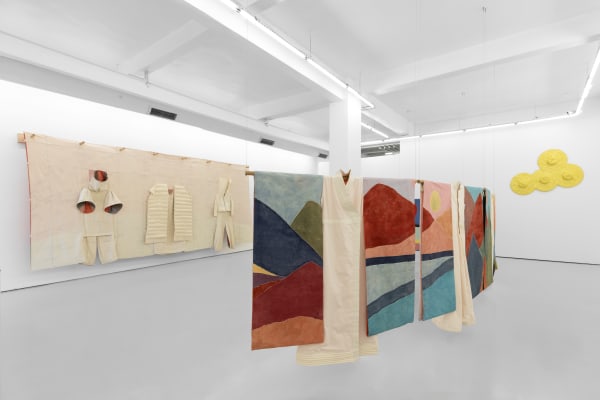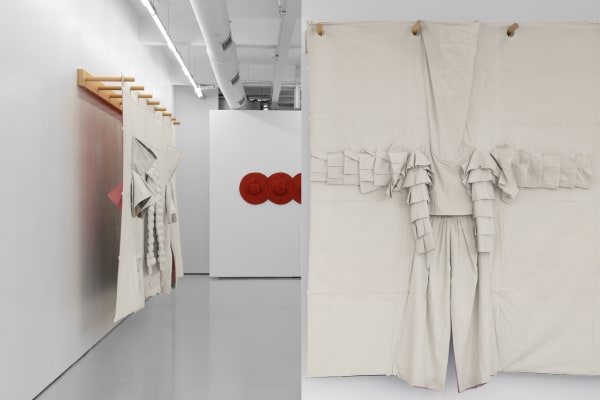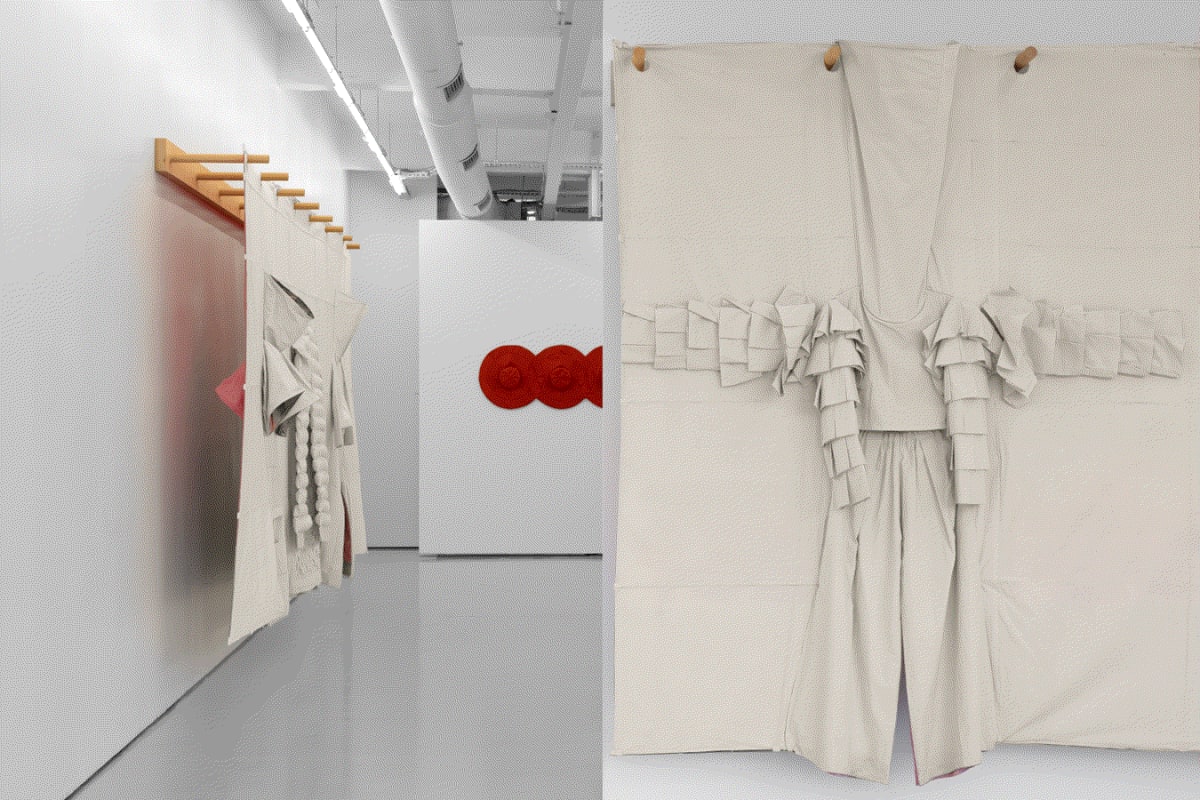Skinscapes: Nefeli Papadimouli
Past exhibition
Press release
THE PILL® is thrilled to present Athens-born, Paris-based artist Nefeli Papadimouli’s first solo show in Istanbul and at the gallery between the dates 30 November 2024 — 25 January 2025. The exhibition presents a selection of the artist’s signature wearable sculptures alongside a series of photographs and graphic notations centered around the title “Skinscapes” as a conceptual framework to introduce the multifaceted practice of Papadimouli moving between architecture, sculpture, and performance.
Challenging notions of individuation and separation between bodies and the environment, the term “skinscape” is the title Papadimouli has given to a series of wearable, connective sculptures that function at once as prompts for collective movement, abstract monochromatic paintings that conceal hidden bursts of color, and architectural interfaces for assembling bodies and negotiating boundaries. Designed in compatibility for multiple human bodies to inhabit and activate them, when hung on the wall, these works are conceived to be “on strike”. In this muted, inactive form, they engage as much with painterly representations of the body, as with archetypal costumes and history of fashion; while in their activated, embodied state, they transform into wearable and portable surfaces, much like a collective skin. They are softened, through movement, into breathing architectural elements that shape space through a synchronized and directed kinetic flow based on spatial partition, constantly transforming how a given architecture and rhythm is experienced, used and conceived by the public.
A series of polaroid prints and graphic notations accompany these central pieces through a rhythmic deployment in the gallery’s space, revealing traces and studies from Papadimouli's activations of these same sculptures in collaboration with performers and audiences. Using the scale of the human body to measure reality, the drawings in the "Relational Cartography" series deploy choreographies of collective movement made possible by these sculptures. The geometric backdrop made of assemblages of pink and blue millimeter paper references the grid as the foundation of modernist abstraction, while the circular, interconnected, multidirectional patterns of movement drawn by the artist introduce elements of contingency and unpredictability, embracing the improvisational and spontaneous aspects of collective experimentation to question the margin of free movement in everyday spaces. Grounding the ensemble in the artist's study of the body in relation to space, the Polaroid photographs document activations of Papadimouli’s sculptures, where movement expands the visual and spatial boundaries of the body in bursts of spectacular deployment like wings or feathers.
With a background in architecture and visual arts, Nefeli Papadimouli works across media, from participatory actions in public space to sculpture, photography, drawing, costume design, moving image, installation and performance. Inspired by phenomenology, feminism and contemporary political theory, her proto-architectural approach explores spatial configurations of distance as essential elements in processes of social conflict, negotiation and equilibrium. Informed by utopian architectural and artistic avant-gardes as much as contemporary dance, her series of modular, connective, elastic sculptures function at once as prompts for collective movement and architectures of assembly, investigating the interdependence of cultural and natural forms and exploring the notion of space through its relationship to the body.
Nefeli Papadimouli (b. Athens, 1988) lives between Paris and Athens. She holds a BA from the School of Architecture of the National Polytechnical University of Athens, followed by an MFA at the Ecole Nationale Supérieure de Beaux-Arts de Paris, and an MFA from Le Fresnoy-Studio National. Papadimouli was the recipient of the Artworks Fellowship from Stavros Niarchos Foundation (Greece, 2018); the Prix Dauphine pour l’Art contemporain (France, 2019); the Prix Matsutani (2022), and the Prix Pierre Cardin of the Académie des Beaux Arts for sculpture (2023).
Her recent solo exhibitions include Étoiles partielles, cur. Claire LeRestif, Le Crédac, Ivry sur Seine (France, 2023); Relational Cartographies, cur. Keren Detton & Janny Devrient, Ter Posterie, Rosealare (Belgium, 2022) and Build the World of the You - ACTE, Le Concept, École d’Art du Calasisis, Calais (France, 2021). She has participated in institutional group exhibitions such as How To Hold Your Breath - 9th Asian Art Biennial (Taiwan, 2024); Crossing The Water - 17th Lyon Biennale (France, 2024); La Nuit venue, on y verra plus claire, cur. Anna Milone, Centre Culturel Jean Cocteau, Les Lilas (France, 2024); Etre Forêts, Fondation MABA, Nogent-sur-Marne (France, 2024); Entre là, Casa Conti - Fondation Ange Leccia, Corsica, (France, 2023); Douze preuves d’amour, Révélations Emerige 2022, cur. Gaël Charbau, Paris (France, 2022); Transmeare, cur. Ida Soulard & Ulla von Brandenburg, FRAC Picardie, Amiens (France, 2022); Playground Festival, M Museum Leuven, (Belgium, 2021); Archipel - quatres residences, mille experiences, cur. Keren Detton, FRAC Grand Large, Dunkerque (France, 2021); Still Here Tomorrow, cur. Dimitra Nikolou & Panos Giannikopoulos, Stavros Niarchos Foundation Cultural Center, Athens (Greece, 2019); Imaginary homes, 6th Biennale of Contemporary Art, cur. Syrago Tsiara, MOMUS Museum, Thessaloniki, (Greece, 2015); CAUTION! SLIPPERY GROUND, cur. Yelta Köm, Istanbul Modern, Istanbul (Turkey, 2015).
Installation Views
Works
-
 Nefeli Papadimouli, Dream Coat, 2024
Nefeli Papadimouli, Dream Coat, 2024 -
 Nefeli Papadimouli, Relational Cartography | Skinscapes (Leuven, November 2021), 2024
Nefeli Papadimouli, Relational Cartography | Skinscapes (Leuven, November 2021), 2024 -
 Nefeli Papadimouli, Skinscapes (Three), 2021
Nefeli Papadimouli, Skinscapes (Three), 2021 -
 Nefeli Papadimouli, Kind of Us (Chapeau à porter à quatre jaune), 2024
Nefeli Papadimouli, Kind of Us (Chapeau à porter à quatre jaune), 2024 -
 Nefeli Papadimouli, Relational Cartography V Dream Coat (les Lilas, mars 2024), 2024
Nefeli Papadimouli, Relational Cartography V Dream Coat (les Lilas, mars 2024), 2024 -
 Nefeli Papadimouli, Kind of Us (Chapeau à porter à deux bleu), 2023
Nefeli Papadimouli, Kind of Us (Chapeau à porter à deux bleu), 2023 -
 Nefeli Papadimouli, Skinscapes (Oracle and Warrior), 2021
Nefeli Papadimouli, Skinscapes (Oracle and Warrior), 2021 -
 Nefeli Papadimouli, Relational Cartography | Être forêts (Dunkerque, June 2021), 2024
Nefeli Papadimouli, Relational Cartography | Être forêts (Dunkerque, June 2021), 2024 -
 Nefeli Papadimouli, Kind of Us (Chapeau à porter à trois) (rouge), 2024
Nefeli Papadimouli, Kind of Us (Chapeau à porter à trois) (rouge), 2024 -
 Nefeli Papadimouli, Relational Cartography |V Étoiles Partielles (Ivry-sur-Seine, June 2023), 2024
Nefeli Papadimouli, Relational Cartography |V Étoiles Partielles (Ivry-sur-Seine, June 2023), 2024
Exhibition Text
Our psychic skin (to dream collectively)
Aslı Seven
Death unites us, life separates us. Or is it the other way around?
We are present to one another in life, in body, in consciousness – co-presence – forming alliances, families, friendships, collaborations and also animosities, strategies of mimicry and mirroring, for attack and defense. We understand death to be the irreversible separation of the departed from these assemblies of the living, almost as if the departed were isolated in death. Maybe there is an alternative: listening to what happens in between, at the thresholds between life and death.
Through my time engaging with Nefeli Papadimouli's work—her installations, performances, workshops, and reflections—I've come to see her practice as a reimagining of individuation. Traditionally understood as the process of distinguishing a being or an entity as distinct from others, individuation, in her hands, becomes an aesthetic, physical, and cosmological exploration. By reverse-engineering this process within specific spatio-temporal constraints, she creates fleeting moments that disrupt individuation, offering a return to a collective state—a composting of boundaries, where psyche and matter entwine, opening new horizons for collective becoming. For Nefeli, every setting—a gallery, a park, a public square, the realm of dreams, or the skin (our largest organ)—becomes a device for to capture the moment between one momentum of individuation and the next: a temporary return to indivision, the unsettling of boundaries that lift new collective horizons towards new individuations. This, I think, is the conceptual material of her artistic proposal, and it corresponds to a similar unsettling of boundaries between forms and mediums.
At the heart of her exhibition at The Pill is Dream Coat, a series of six double-sided wearable sculptures arranged in a semi-circular formation. Initially, the pieces resemble fragments of a landscape: where sleeves meet, mountain ranges and valleys converge, painting a composition where multiple suns coexist. This landscape unsettling in that it collapses linear time: sunrise, high noon, sunset and everything in between seems to coexist in shifting tones of color between twilight hues and dawn pastels. Yet, these landscapes are interrupted by wearable forms designed for arms, legs, and torsos, bridging the human body and its surroundings. As you focus on these forms, the scene transforms into a collective ritual—a circle of dis-individuated bodies moving in harmony with the solar cycle, celebrating the cosmos and Earth's perpetual rotation.
In the background, three collective hats designed for multiple wearers hang like celestial bodies. Titled Kind of Us, these hats invoke a shared headspace where bodies converge, restrained yet transformed by their connections. These hats, mirroring the suns of Dream Coat, add primary colors to the scene, furthering the interplay between individuality and collectivity.
Behind this tableau lies Nefeli’s research into the possibility of dreaming collectively. Initially conceived as an ensemble of 10 costumes, Dream Coat has been performed so far in two locations, in France and in Taiwan, with a choreography of collective movement based on what she calls “Dreamstorming” sessions among amateur and skilled participants. Through her guidance in in workshops, the group shares recurring dreams and reflections on dreams, arriving gradually and collectively at bodily gestures, as projections of individual and collective memories, embodiments of a shared dream state.
When I ask her about the differences in dreams in one culture and the other, she replies by stating the similarities, recurring motifs of falling, flying or being chased after, to which she adds those of climate anxiety, of natural and manmade catastrophe, emphasizing the idea that our dreams and these recurring motifs have existed before us and they will exist after us, in a metaverse that links different dream places, or a utopia of dreams where we ultimately meet and dissolve into one another.
When activated by multiple bodies moving in space, the Dream Coat costumes transform into expanding and connecting body parts, much like wings. Nefeli refers to them as “corporeal masks” that allow us to transform ourselves into another and connect to one another. The landscape dissolves into vibrant bursts of moving color through the circular movements of performers. Similar to turning dervishes, they seem to connect the earth and the sky, waking consciousness to altered states of mind, where self and other merge.
Her Relational Cartographies, graphical notations of past performances, map the spatial relationships between bodies and environments. These works underscore her ongoing research into the ecosystems that emerge when material bodies interact with their surroundings as spatializing bodies.
The principle of movement, and of dis-individuation applies to Nefeli’s practice as a whole: It is impossible to separate the costume from the painting, the painting from movement, the assembly from the architecture, exercise, embodiment, film, notation, study and photography. Her works are all of these things at once and move between them in a constant flux. This centrality of movement brings her work closer to life and the nature of consciousness within the cosmos.
In contemporary philosophy and anthropology aimed at understanding the nature of life, individuation is conceived as an ever incomplete process of movement. The equation of sameness and distinction is an ever changing one. What comes to define the commonality between beings and entities – humans among themselves, humans and non human beings, living and non living entities, environments - can also shift: is it our bodies while our spirituality differs, or do we share a spirit while our bodies are ontologically different? What are we made of, if not material, spiritual, organic, oneiric, chemical and semiotic relationships and connections?
With Nefeli Papadimouli’s Skinscapes, Kinds of Us and Dream Coat, we can see ourselves not as inserted in autonomy into the world, but rather as continually coming into being within it, moving in a mesh of bodies and materialities, creating spaces and architectures of openness and protection at once, that can breathe and connect to the world, a common connective tissue out of which to grow and into which to disappear, a same psychic skin we share.
Press
Videos






















